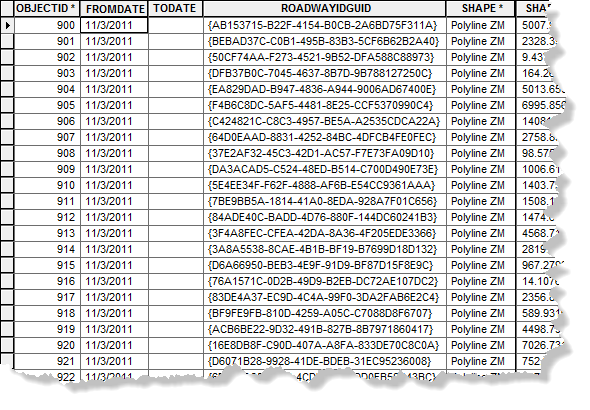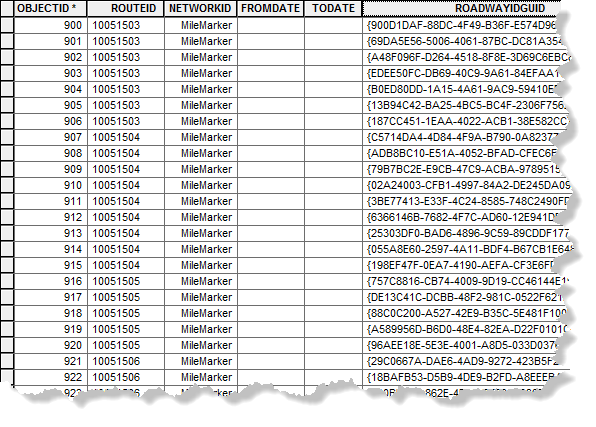This topic discusses the use and implementation of LRS Networks and routes in the advanced linear referencing system (LRS).
What are routes in an LRS?
Routes are linear LRS features that are generated by combining three data elements: centerline features, a record in the network feature class table, and records in the centerline sequence table and calibration point features to provide measures. They are persisted in a feature class, where the shape of the route is generated and updated each time edits are applied to the network or the Generate Routes geoprocessing tool is invoked by a user, model, or process.
Centerline feature class
The centerline feature class is the geometry source from which routes are created and where you defined the geometry of routes. It must have a minimum schema that includes an ObjectID, a RoadwayIdGuid field, and From and To date fields. The RoadwayIdGuid is a system-generated globally unique identifier (ID) that ArcGIS Roads and Highways internally uses to map centerlines to routes. The centerline feature class can be given a name that is appropriate to your business, but you may have only one centerline feature class per LRS.

Centerline sequence table
The centerline sequence table determines the way routes are constructed with respect to the route table. The centerline sequence table is a cross-reference table that manages the many-to-many relationships between centerlines and routes. It instructs the LRS to build routes in a particular way so they can be easily calibrated and measured. Centerline sequence must include the RoadwayIdGuid, the RouteId, the LRSNetworkId, and From and To dates.

How are LRS Networks and routes used?
The primary purpose of LRS Networks and routes is to allow each business unit to have its own definition of a route based on the same centerline geometry. In highway terms, a route is a set of roadway elements that has an official highway name. United States Route 60 (US60) is an official route along the United States National Highway System (NHS). When discussing a route in a highway system, highway engineers are usually referring to the specific officially named route or a portion of an officially named route.
Unfortunately, even highway engineers within the same highway department don't always agree on what the official name of a route is. This is not due to confusion about terminology. Rather, it is because each business unit within a highway department has a specific business need for defining a highway, or a portion of a highway, a certain way. All highways that participate in the NHS (National Highway System) have an official, nationally recognized name or designation, but a state Department of Transportation (DOT) may employ a different set of names and designations for the same set of highways. The DOT names are just as valid, and just as official, as the NHS name, but they define the highway in a way that is more useful to the specific business unit of the DOT. For example, the DOT may elect to use a road inventory identification number instead of a highway designation and number. This is particularly useful when measuring the highway system because it doesn't require road crews to measure the entire highway all at once.
Even within a single DOT there may be several definitions of the highway, each one just as valid and official as any other. To distinguish between the various highway definitions, the LRS supports the concept of the LRS Network. The LRS Network is, among other things, a collection of LRS routes that have a specific set of names and segmentation pattern. For example, one LRS Network may contain all the LRS routes within a highway system that have NHS highway names. Another LRS Network may contain the same highways using road inventory names. Each of these may be segmented differently. US60 may be represented as one route in one LRS Network, but the same highway may be represented by a dozen or more roadway inventory control sections in the other LRS Network. It is important to understand that these LRS Networks utilize the same geometry and that any given road feature may participate in multiple LRS Networks within the same LRS. In fact, a road feature may participate in multiple LRS routes within the same LRS Network. The LRS's ability to aggregate centerline segments into routes is what makes this possible.